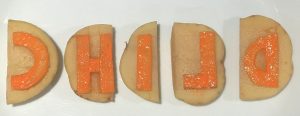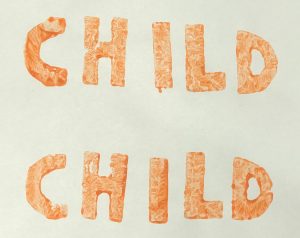
As I tried this potato stamp activity on National Day of Truth and Reconciliation in Canada on September 30, I decided to create the stamps for the word, “child” from the slogan Every Child Matters in orange to reflect on the meaning of the orange shirt.
Before starting with the process of carving or cutting out the shapes on the potatoes, I sketched the desired images of the letters on paper, examined them and planned how and what configuration of the letters need to be carved on the potato pieces.
H and I are symmetrical both horizontally and vertically, so they were the easiest letters to carve as I just needed to carve the letters as I see them on paper. Also, even if I stamp them flipped, the correct images will be produced.
C, L, and D are asymmetrical so there were some plans and confirmations required in designing these letters.
C and D are easier than L as they are asymmetrical only in the horizontal direction (vertically symmetrical) while L is asymmetrical in both directions.
At first, I thought I would have to take the horizontally flipped images of C and D to create the correct stamps, but as they are vertically symmetrical, it was fine to carve the letters as I see them on paper, just like H and I. After creating the stamps, I just needed to rotate them 180 degrees then I could produce the correct images of C and D on paper.
For the letter L stamp, I took the mirror image of L to carve on the potato.

As the three stamps required attention to the direction of holding them when stamping, I wrote the letters on the top of the stamp “handles” to indicate how I would need to hold them to stamp the letters correctly.
Before printing the word in a good copy, I tried stamping on scrape paper a few times. I tried dapping the stamps directly in the paint and the outcome was not so successful. So, I tried brushing the paint on the stamp to ensure that the surface is evenly coated and it was much better. I tried stamping on paper placed on the surface of the table, and some of the letters were not printed clean as the surface of the potato stamps was not flat and smooth. So, I tried putting a towel underneath the paper and the cushion from the towel helped printing the letters evenly.

As you can see from the first letter from the first copy of the word, more paint was printed. Cut-out potatoes tend to develop moisture on the open surface, so before applying the paint on the stamp, I dried the surface first to control the amount “ink”.
The whole process of designing the images, creating the stamps and printing the word twice took me about 40 minutes. I was only creating an image of a 5-letter of word, but if I was printing a book or a page-length document using this method of printing, it would take so much time and effort.
However, considering the time, cost and the amount of man-made mistakes in handwriting, the letter press system in mechanization of writing is far advanced and as long as the stamps are available to use, reproducing the text is much faster than handwriting.
This week’s activity has made me appreciate the convenience of writing technology that we have today. Type, erase, copy, paste, and print. So convenient!